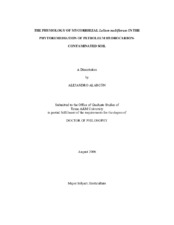| dc.description.abstract | Arbuscular mycorrhizal fungi (AMF) can play an important role in the
phytoremediation of petroleum hydrocarbon (PH)-contaminated soil. However, little is
known about the effects of AMF in combination with biostimulation via fertilization or
bioaugmentation with hydrocarbonoclastic microorganisms, during phytoremediation of
PH in soils.
This research evaluated the influence of the AMF Glomus intraradices and
inorganic fertilization on growth and physiological responses of Lolium multiflorum Lam.
cv. Passarel Plus during phytoremediation of soil contaminated with Arabian medium
crude oil (ACO). Also determined was the interaction of AMF with the
hydrocarbonoclastic bacterium, Sphingomonas paucimobilis EPA505 (Sp), and the
filamentous fungus, Cunninghamella echinulata var. elegans ATCC-36112 (Ce), on
growth and selected physiological responses of L. multiflorum during phytoremediation
of soil contaminated with benzo[a]pyrene (BaP) or ACO.
This research provides evidence that AMF enhance the phytoremediation of
petroleum hydrocarbons in soils when inoculated with L. multiflorum. The concentration
of petroleum hydrocarbons in soil was a determining factor of potential benefits of AMF on L. multiflorum. Low (3000 mg·kg-1) or high (15000 mg·kg-1) concentrations of ACO
resulted in limited benefits of AMF on plant growth, physiology, and degradation of
ACO in soil. However, when plants were exposed to an intermediate ACO concentration
in soil (6000 mg·kg-1), AMF plants had enhanced growth, physiological responses, and
greater ACO-degradation than non-AMF plants. The AMF symbiosis in roots of plants
was observed at all concentrations of ACO-contaminated soil.
This research is one of the first reports demonstrating the benefits of AMF on the
degradation of benzo[a]pyrene or ACO, alone or in combination, with the
hydrocarbonoclastic microorganisms. Thus, AMF resulted in a beneficial synergism with
the hydrocarbonoclastic microorganisms, particularly during ACO-degradation in the
rhizosphere of L. multiflorum. Hydrocarbonoclastic microorganisms had no negative
effects on AMF colonization. | en |


